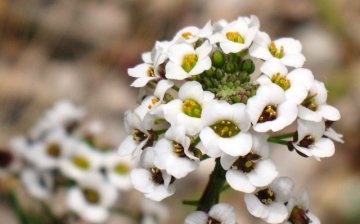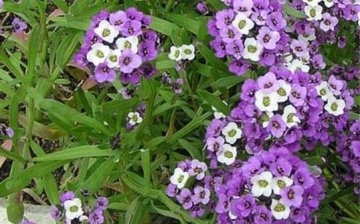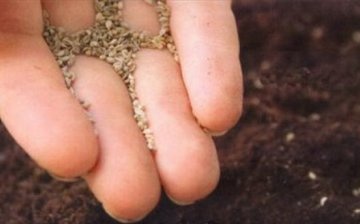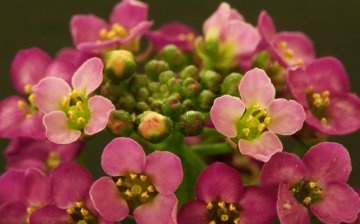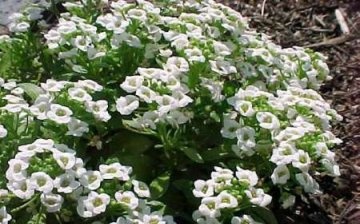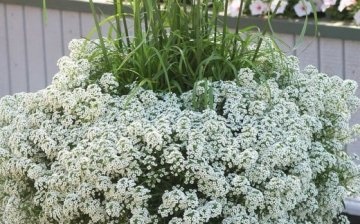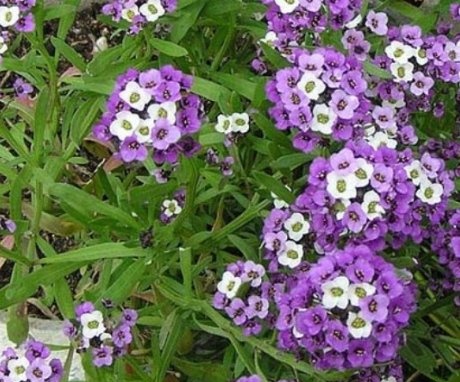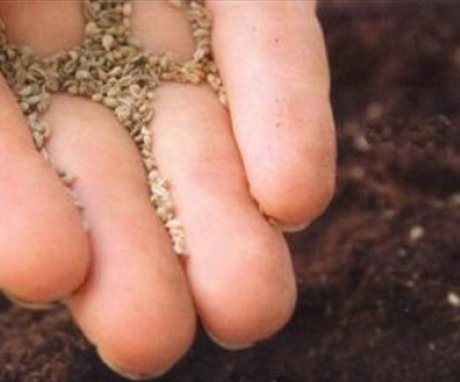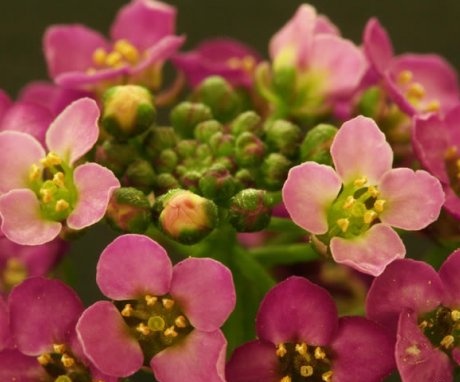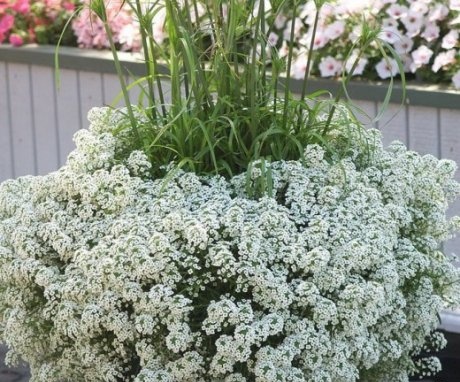Alyssum marine: description, reproduction and care of the plant
When working on the design of a garden plot, professionals give preference to decorative, picky and easy-to-propagate plants. Such "favorites" include sea alissum.
Content:
- Alyssum marine: getting to know each other better
- Seed propagation
- How to grow and plant seedlings of sea alyssum?
- Alyssum marine care
- Alyssums in garden design
Alyssum marine: getting to know each other better
Plant from the genus Alyssum (Cabbage family). The history of the name "alyssum" is interesting. It consists of two Latin words meaning "denial" and "canine rabies": in ancient times, the culture was used as a cure for the disease of the same name.
Alyssum marine is known as sea lobularia, beetroot.
Its natural area is Southern Europe. The origin of another name for the plant (stonemason) is explained by the fact that in its homeland the flower covers the foot of the rocks and rubble soils with beautiful fluffy carpets.
Description of the plant:
- Alyssum Marine - compact or spreading, rather dense shrub.
- Height - from 8 to 40 cm.
- Its curly stems and flowering shoots (4-5 pieces on each bush) are covered with small narrow-lanceolate leaves.
- The inflorescences form small flowers of various shapes, lavishing a rich, pleasant honey aroma.
- The plant blooms in June and adorns the garden until the end of autumn.
The stonemason's palette depends on its type. Breeders have specially bred plant hybrids, which are distinguished by abundant flowering.
Some of the popular types of lobularia marine:
- White (Snow Krystals)
- Cream (Rosie O'Day)
- Easter Bonnet Pink
- Red (Wonderland)
- Purple (Royal Carpet)
- cream (Easter Deep Rose)
Alyssum marine attracts not only by its appearance, but also by its breathtaking aroma.
Seed propagation
After flowering, fruits are formed - oval pods with a pointed tip. Inside - small seeds (1 g - 3000 pieces). Their tone depends on the variety: yellow in white flowers, orange-brown in purple flowers.
The seeds are harvested after the pods turn yellow.
The stonemason, due to the excellent germination of the planting material, belongs to popular industrial crops. It does not lose its properties for 3 years after collection. Lobularia seeds are sown in open ground on a plot intended for a flower. This can be done either in the spring at the end of April (with stable heat), or in the fall in mid-October (before the first snow).
Technology:
- Dig up the soil and sprinkle with calcium flour.
- Sow the planting materialspreading it evenly over the surface.
- Carefully tamp the soil together with the seeds. It is not recommended to sprinkle it on top with earth: a lack of sunlight will slow down the germination process.
- Drizzle, but do not pour.
- After seeing the first shoots, wait 2 weeks and thin out the plants. The distance between the stone masons is 15 cm. Such actions stimulate flowering and prevent diseases.
Flower sprouts will appear in 7 days if the air temperature does not drop below 160C. Sea alyssums planted in open ground will bloom in 2 months.
The high germination rate of lobularia seeds allows even a novice gardener to successfully cultivate it.
How to grow and plant seedlings of sea alyssum?
The seedling method allows you to accelerate flowering. They begin to work with the arrival of spring. Stock up on small boxes and light soil with good drainage. It is recommended to add lime to the substrate.
The planting material is sown over the surface, pressed with the palm of your hand. After watering, the containers are covered with foil or glass. At a comfortable temperature (from 16 to 200C), the sprouts will appear in 7-10 days. Seeing young stonemasons, the protection is removed. The sprouts need to be equipped with additional lighting.
Waiting for the appearance of three real leaves, dive... Between young lobularia leave 5 cm in a large box. Individual specimens can be transplanted into small pots.
In May, the seedlings are taken out into the open air to harden the plants.
Permanent residence is determined at the end of spring. Approximately 14 days before the planned event, it is advisable to fertilize the soil with organic fertilizing. The size of the prepared pits must exceed the size of the rhizome. After planting, the flowers are watered abundantly.
It is important to maintain a sufficient distance with neighboring plants, otherwise the sea alyssum will not be able to develop freely. Gravel or sand is added to heavy soil. So that after watering the water does not stagnate, drainage is laid.
Alyssum marine is propagated not only by seedlings. In practice, cuttings and division of the bush are used.
In the first case, the shoots are cut in the middle or late summer. They are planted under sheltered light, nutritious soil. Watering actively.
In the middle of spring, old specimens are dug up, divided into parts. Each should have enough shoots. The bushes are planted keeping a distance of 30 cm between the plants. Compared to the seed method of propagation, the seedling method is more laborious, but it allows you to see the blooming sea alyssum faster.
Alyssum marine care
Plants are undemanding to growing conditions. However, there are nuances that will allow you to see especially lush bushes:
- The plant loves sunny areas. In insufficient light, it blooms poorly or does not emit inflorescences at all.
- Feels good on limed, nutritious, sufficiently moist soils. Overabundance humus in the soil will force the plant to actively increase the green mass at the expense of flowering.
- It is a frost-hardy plant that will withstand sharp fall and spring temperature drops. She does not need shelter for the winter.
- During the summer, the bushes are trimmed several times. Such actions support decorativeness and increase the flowering period. The stems are cut by no more than 8 cm.
- Abundant watering is not needed. The stonemason has enough natural precipitation. If there is a prolonged drought, the plant is watered during the budding period.
- An excess of water will lead to decay of the rhizome.
- On a fertile area, the bushes are fed once in the spring.
- During weeding, the soil is loosened, which increases its ability to pass water and air.
- Alyssum the sea rarely gets sick. In an unfavorable environment, it is damaged powdery mildew, brown rot, viral mosaic of cauliflower and jaundice of asters. The beetroot can be attacked by cabbage moth, cruciferous flea and turnip white beetle.
Those who have followed all the recommendations for caring for lobularia will receive a reward in the form of colorful, long-flowering bushes.
Alyssums in garden design
In interior decoration beetroot plots are used very often. This plant, originally from the mountains, seems to have been specially created for compositions with stones and sunny rock gardens. The flower will grow on the balcony and outdoor terrace. The lobularia will fill the cracks in the stone walls, the crevices between the slabs, which are paved with the patio. It will ideally coexist with boulders and large stones in rockeries.
Since the plant is well-cut and develops quickly, borders are drawn up for it. Low-growing varieties are planted in mixborders, beds and flower beds, placing them in the foreground.
The rapidly growing sea alyssum will fill the area of the flower beds. This is a chic floral carpet on the lawn. Stonemason will perfectly disguise faded tulips, daffodils, crocuses.
Suitable partners for him will be heliotropes, levkoi, pelargonium, turkish carnationse, bearded dwarf irises, forget-me-nots, red tulips and roses... When developing the interior, you can play on the contrast of shades: white sea alyssum will stand out against the background of carmine red, pink or purple flowers.
Other popular varieties of alyssum used in landscape design:
- Alyssum is rocky. Strongly branched perennial, reaching a height of 25 cm. Elongated leaves form dense rosettes. The yellow flowers are collected in short, dense clusters.
- Alissum snow carpet. An annual shrub that grows only 8 cm. But its width is 20 cm. Small oval leaves are covered with villi. White flowers are very beautiful.
- Alyssum creeping. Height - about 60 cm. Leaves are gray-green. The yellow inflorescences are small.
- Alissum Gmelin. It grows up to 20 cm. The upper and lower leaves differ in shape. The flowers are yellow.
- Alyssum Iberian. Fleshy foliage, covered with a delicate down, shimmers with silver. Reaches 20 cm. Inflorescences are white.
- Kamennik is a favorite plant of designers when decorating rocky areas and rock gardens.
Alyssum sea, fragrant with honey, will be a worthy decoration of any garden. It can be raised not only by professionals, but also by amateurs.
More information can be found in the video.



